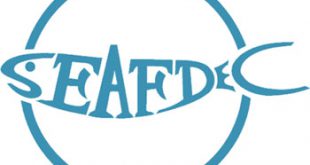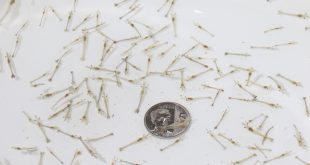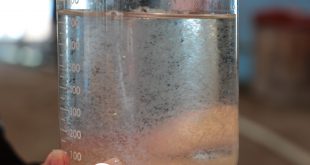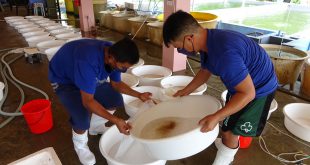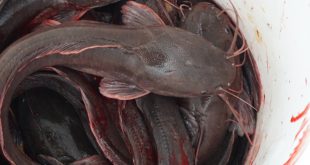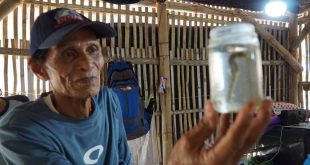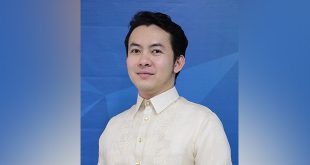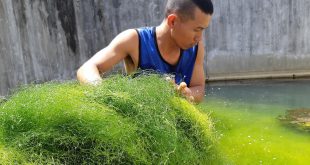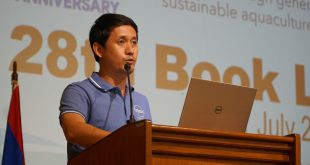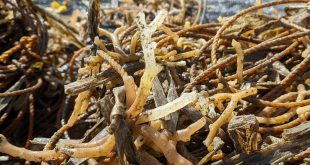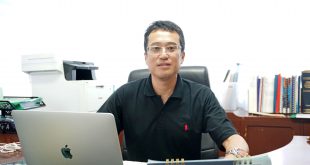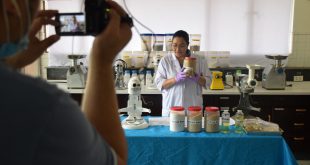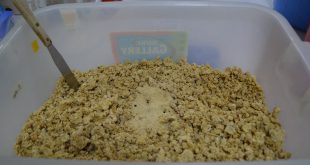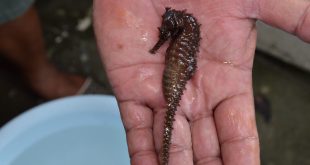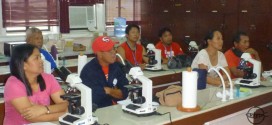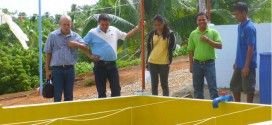Vacancies: 2 ASSOCIATE RESEARCHERS (entry position; could be a RESEARCHER depending on the qualifications) to be assigned at the Binangonan Freshwater Station, Research Division in Binangonan, Rizal. Qualifications: Master or Doctorate Degree in Biological Sciences, Fisheries or related fields Preferably: With at least one (1) scientific publication categorized under any of the following: Science Citation Index Expanded (SCIE), Social Sciences Citation Index (SSCI), and Arts and Humanities Citation Index (A&HCI) as a senior or first author; With at least 1-2 years experience in aquaculture or fisheries research; and Dedicated and focused in work, trustworthy, and with good work ethics. Summary of duties to be performed: The position entails the conduct of research studies and publication of the results of …
Read More »webmaster
Shrimp birthing center ends unnecessary abortions
Back in 2018, eggs from infected shrimp spawners would be promptly chlorinated and disposed – all 200,000 to 1 million of them per brood – to quell notorious pathogens that continue to devastate shrimp farms worldwide to the tune of billions of dollars yearly. This was the practice at the SEAFDEC/AQD Tiger Shrimp Spawner/Broodstock Facility in Iloilo, Philippines where incoming spawners are screened for pathogens, through polymerase chain reaction (PCR) tests, before allowing their eggs into a highly biosecure hatchery. Upon releasing their eggs, the spawners, are tested for the white spot syndrome virus (WSSV), monodon baculovirus (MBV), infectious hypodermal and hematopoietic necrosis virus (IHHNV), yellow head virus (YHV), acute hepatopancreatic necrosis disease (AHPND), and the parasite Enterocytozoon hepatopenaei (EHP). To …
Read More »Revived hatchery signals major step towards Philippine milkfish fry sufficiency
The embattled milkfish industry in the Philippines got a shot in the arm as the first rehabilitated hatchery in Western Visayas, which is expected to produce 5 to 10 million bangus fry every year, started its operations to address the persistent shortage of milkfish seeds in the country. Located in the province of Aklan, the 1,787 square meter Batan Bangus Satellite Hatchery was launched in February this year under the National Fry Sufficiency Program of the Department of Agriculture’s Bureau of Fisheries and Aquatic Resources (DA-BFAR). The hatchery used to produce shrimp fry in 1983 but outbreaks of diseases in shrimp during the 90s led the hatchery to cease its operations in 1995. Now, it is one of the central …
Read More »Youth called to engage in aquaculture to secure fish supply
The African swine fever threatening the protein supplies of the country still grappling with the COVID-19 pandemic prompted the chief of an international research center to call for more youth to be involved in aquaculture. “Now, more than ever, is the time for our youth to engage in the efficient production of healthy protein through aquaculture,” said Dan Baliao, chief of the Southeast Asian Fisheries Development Center Aquaculture Department (SEAFDEC/AQD) based in Iloilo. Baliao said fish is more efficient to produce than even poultry, taking as little as 1 kilogram of feeds to produce 1 kilogram of fish. Yet, there are not enough skilled personnel to competently build and run fish farms in the country. Data from the Commission on …
Read More »A hard problem with a soft solution: Catfish farm’s production surges after easy fix
There are not enough catfish in the “Catfish Country” of Zarraga, Iloilo, but recent findings in one farm may just be the catalyst that could catapult the fish into abundance. Zarraga Pantat Fingerlings was one of the many farms struggling to keep pace with buyers’ demands while itself suffering from many catfish eggs that fail to hatch and catfish fry that die before they can be sold to other farmers that grow them in ponds. Larry Pañoso, the hatchery operations in-charge, said that they achieved a breakthrough in January when their production reached an all-time high of 500,000 fry per week after the Southeast Asian Fisheries Development Center Aquaculture Department (SEAFDEC/AQD) helped resolve a problem with their water …
Read More »Community-based sea ranching: fisherfolks’ legacy to sustainable fisheries
Just off Molocaboc Island, beneath a turquoise canopy of water, fishers search the coral reef to pick out abalone and sea cucumber, two prized delicacies in Asian cuisine. Live abalone sells abroad for up to $120 or approximately P5,700 a kilo, and dried sea cucumber, $2000 or about P96,000 a kilo. But the fishers are not here to cash in on the abalone grazing on coralline substrates and the sea cucumber burrowing in the white sand. Not yet. They carefully weigh and size them, log the numbers in a notebook, and return them to the reef to continue to grow and reproduce. During the formative years of the sea ranching project, the fisherfolks asked when they will benefit from the …
Read More »Profiles in Science: Peter Palma and the Case of Serendipity
Being a scientist was never part of his career plan, but this young researcher is already making waves in aquaculture research with his award-winning study on the giant grouper, a “threatened” fish locally known as lapu-lapu. Peter Palma and his team recently bagged the prestigious Dr. Elvira O. Tan Awards – Outstanding Published Paper in the Aquatic Science Category for their paper that studied the sexual development of the hermaphrodite fish and debunked presumed norms on the origin of the male giant grouper. Their paper titled “Reproductive development of the threatened giant grouper Epinephelus lanceolatus,” published in the Aquaculture Journal last July 2019, presented evidence that male giant grouper do not need to pass through a female stage at an earlier …
Read More »‘Spaghetti’ fed to shrimp in bid to cut aquaculture cost
Humans are not the only ones who enjoy eating spaghetti—shrimp can, too. Researchers are using nutritious green “spaghetti algae” in fish and shrimp feeds as part of a broader move to bring down the cost of expensive aquafeeds which account for over half the expenses of farmers. “The ultimate aim of using spaghetti algae, or any other alternative ingredient, in aquafeed is to bring down the feed cost in aquaculture,” said Joseph Biñas, associate researcher and feed mill supervisor at the Southeast Asian Fisheries Development Center Aquaculture Department (SEAFDEC/AQD) in Tigbauan, Iloilo. Biñas further said that, “The use of alternative ingredients, especially if these are locally available and sustainably produced, may considerably reduce the cost of formulated feeds.” Chaetomorpha linum, …
Read More »SEAFDEC/AQD librarian is 2020 PRC Outstanding Professional Awardee
Stephen Alayon, head of the Library and Data Banking Services Section, joins the roster of Outstanding Professional Awardees chosen by the Professional Regulation Commission (PRC) of the Philippines. Under the Business Education and Social Services Cluster, Alayon is the sole librarian bestowed with the award. According to PRC, the Outstanding Professional of the Year award is the highest recognition conferred by the commission to individuals who excelled and contributed significant impacts to society in their line of expertise. He finished both Bachelor of Science in Computer Science and Master of Education (Mathematics) degrees at the University of the Philippines Visayas. He also graduated with a Master of Library and Information Science (MLIS) degree at the Central Philippine University (CPU). Under …
Read More »Disease-afflicted PH seaweed farms see hope with help of scientists
Seaweed farming, a multi-million dollar export industry in the Philippines, is at the centerpiece of a worldwide effort by scientists to better address the outbreak of diseases and pests that are plaguing the farms. With an estimated 116,000 families in the country reliant on seaweed farming, SEAFDEC/AQD as part of the UK Research and Innovation (UKRI) – Global Challenge Research Fund (GCRF) GlobalSeaweedStar Project, is working to better understand outbreaks of “ice-ice” disease and epiphyte infestations in farms which have inflicted losses worth as much as 15 percent of the total seaweed production. According to Joseph Faisan, Jr. an associate researcher at SEAFDEC/AQD, “ice-ice” disease (IID) outbreaks are caused by extreme environmental conditions (temperature, salinity, pH, siltation) and are characterized …
Read More »Japanese conservation biologist is new deputy chief of SEAFDEC/AQD
The Southeast Asian Fisheries Development Center (SEAFDEC), a regional treaty organization that promotes sustainable fisheries among its 11 member countries, welcomed the new deputy chief of its Aquaculture Department (AQD) based in Iloilo last Oct. 20, 2020. Dr. Sayaka Ito, a Japanese scientist with expertise in aquatic conservation biology, replaced fellow Japanese Dr. Koh-ichiro Mori who served as the Deputy Chief from April 2018 to June 2020 in this organization that is mandated to conduct scientific research to generate aquaculture technologies, develop skilled manpower for the aquaculture sector, and disseminate aquaculture information. Upon endorsement by the Government of Japan, SEAFDEC Secretary-General Malinee Smithrithee appointed Dr. Ito to a 2-year term from Oct. 1, 2020 to Sept. 30, 2022 wherein …
Read More »It’s online learning for PH aquaculture extension workers
Learning online isn’t just for students, it is also for the Philippines’ aquaculture extension workers who listened to lectures and practical sessions on milkfish and mangrove crab culture via an online platform. Forty-eight participants, mostly staff of the Bureau of Fisheries and Aquatic Resources (BFAR) from the different administrative regions, recently completed the FishKwela Training Course to enhance their skills on the hatchery production of milkfish and mangrove crab. The training course was the first technology and commodity-based online training course prepared by the Southeast Asian Fisheries Development Center Aquaculture Department (SEAFDEC/AQD) in collaboration with the National Fisheries Research and Development Institute (NFRDI). Although SEAFDEC/AQD has been conducting online courses on fish health management and aquaculture nutrition since 2002, Caryl …
Read More »Agri-wastes eyed as cheap, eco-friendly source of fish feed
AFFORDABLE and sustainable feed ingredients for fish farmers are in the works as researchers continue to develop fish diet formulations using discarded agricultural wastes and byproducts. Dr. Frolan Aya, a scientist at the Southeast Asian Fisheries Development Center Aquaculture Department (SEAFDEC/AQD), and his colleagues examined agricultural wastes and byproducts for potential inclusion in diets formulated for omnivorous fish such as Nile tilapia (Oreochromis niloticus) in their study, “Potential use of agricultural wastes in aquafeed production.” Fruit peels, pulps or brans, seeds, bagasse (sugarcane residue), molasses, and okara (soybean curd residue) comprise 40 to 60 percent of wastes generated from major crop industries such as coconut, banana, pineapple, mango, citrus, and sugarcane. While these agri-wastes have found some use as organic …
Read More »Seahorses get second life with SEAFDEC and NegOc islanders’ help
The coral reefs north of Negros Island are once more teeming with seahorses after a seven-year partnership between researchers and the local island community successfully protected and replenished their wild population. At Molocaboc Island in Sagay City, Negros Occidental, divers assisted in scientific surveys of seahorse populations, technicians maintained seahorse breeding facilities, the local government’s Bantay Dagat (sea patrol) enforced protection, and schools gladly embraced information and educations campaigns. The island is within the Sagay Marine Reserve, a marine protected area chosen as the project site of the Southeast Asian Fisheries Development Center Aquaculture Department (SEAFDEC/AQD) to protect and revive the dwindling population of the tiger tail seahorse (Hippocampus comes). During assessments done from 2012 to 2013, local divers …
Read More »Eight trainees learn mud crab culture from AQD
A special course on “Mud crab hatchery and nursery” was conducted by SEAFDEC/AQD held at the Tigbauan Main Station in Iloilo, Philippines from 23 September to 9 October
Read More »AQD and BFAR team up for Winrock project
SEAFDEC/AQD Chief Dr. Felix Ayson, Training and information head Dr. Evelyn Grace Ayson and Information assistant Mr. Caryl Vincent Genzola had a consultation with officers of BFAR
Read More » SEAFDEC/AQD Southeast Asian Fisheries Development Center | Aquaculture Department
SEAFDEC/AQD Southeast Asian Fisheries Development Center | Aquaculture Department
